For anyone that’s been outside in a Canadian winter (or UK summer!), you’ll know how unpleasant it can be to do anything.
But when you’re working in the cold weather – that’s a whole other level.
Beyond the freezing hands, wind chilled face and general lack of energy, working outside comes with some more serious dangers.
According to OSHA, slips, trips and falls due to icy conditions make up 20% of all workplace injuries and 15% of workplace deaths.
So, let’s dive into what you can do to protect yourself and your team with the power of ergonomics.
15 Tips for Working in Cold Weather
Clothing 🦺
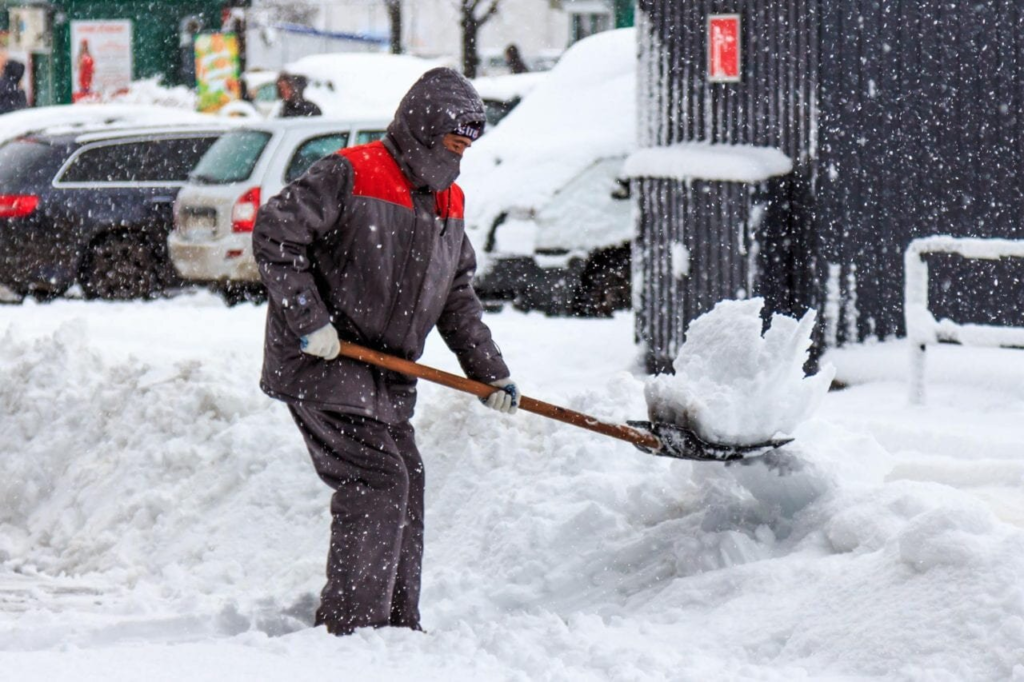
When dressing for cold work, just remember the three elements of your momma’s lasagna: layered, hot around the edges, and completely devoid of moisture.
#1 💡 Layer Up
Let’s start with the obvious: more clothing means more heat.
But it’s not about piling 5 or 6 layers on. You can achieve total workplace cold weather safety with just three…
- A sweat-wicking base layer to keep any sweat off your body.
- A fleece middle layer to trap heat within your clothing
- A windproof and waterproof jacket top layer to keep the elements at bay.
Working like this, with just a few highly efficient layers, is better for mobility and safety when on the job.
#2 💡 Care for your Extremities
Hat on your head, gloves on your hands, boots on your feet. It seems pretty simple, but so many outdoor workers neglect to look after their head, hands and feet in the ‘heat’ of battle with the job.
The fact is that keeping your extremities warm keeps your body warm.
With an insulated hat, pair of gloves and pair of boots, you’re reducing your chance of frostbite and hypothermia. So, be sure to treat them like the VIPs that they are.
#3 💡 Stay Dry
Wet clothes steal heat super quickly.
Any bit of clothing that could vaguely be described as damp can lower your body temperature and put you at the mercy of the elements around you.
You may find it impossible to avoid your clothes (especially your middle and outer layers) from getting wet, so we’d highly recommend packing extra dry clothes.
Every few hours, you can change into a new bit of dry kit, thereby preserving your body heat.
Scheduling 📅
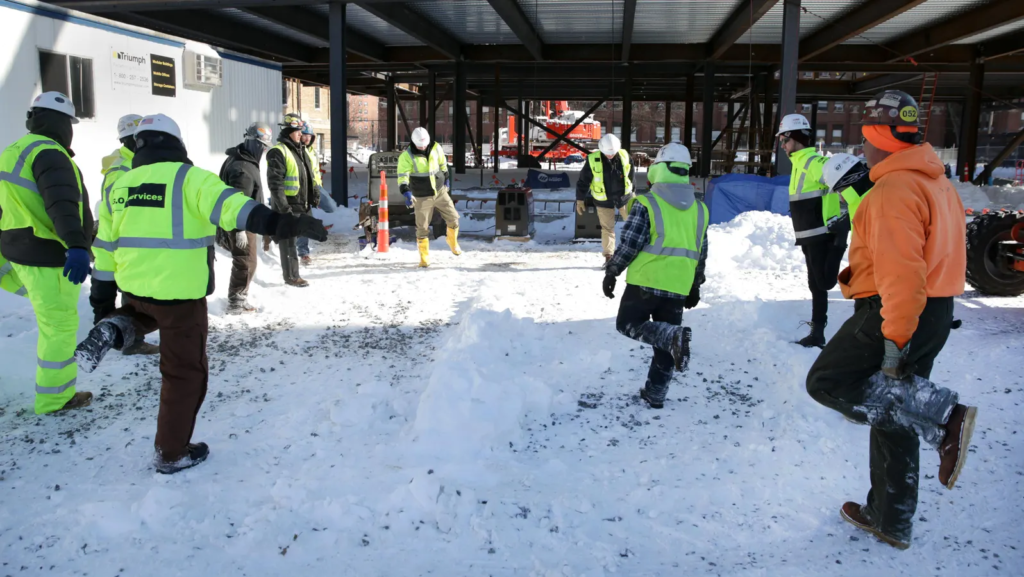
Cold got you shivering like a leaf in a blizzard? Take a break – your body needs a timeout from the freeze.
#4 💡 Time your Work
It’ll come as no surprise to hear that some parts of the day are inherently warmer than others.
Between 3pm and 5pm are the warmest parts of any day, as sunlight is absorbed by the ground and is being released during those times.
For the highest level of safety in cold outdoor workplaces, do the bulk of your work during these peak temperature hours.
#5 💡 Find a Warm Spot
A heated shelter is a god-send for outdoor work environments, especially when it’s below -7°C.
However, not every worksite has one. Farm from it, in fact.
Warm break shelters should be provided by your employer, but many workers are left to find their own shelters to seek refuge from the bone-chilling weather.
Make sure that whatever shelter you have, or find, you’re protected from the wind and cold as much as possible.
#6 💡 Take Regular Breaks
It’s not just about where, but how often you take your breaks.
Current cold weather safety guidelines suggest a 5-minute break about every 45 minutes.
Giving your body, especially your extremities, a regular break from the cold can be super beneficial for both your health and productivity.
#7 💡 Keep it Moving
Outdoors, you can feel the cold fast when you let it wash over you.
Hopefully, your outdoor work requires you to move around, as moving around generates body heat that keeps your internal temperature at a healthy degree.
If not, try to incorporate some movement into your working day.
- Walk around the site more
- Try stretching on your breaks
But there’s a fine balance when it comes to movement – don’t overdo it because that can lead to sweat, which leads to damp clothes.
Damp clothes in the cold can freeze easily, casing you in a mini ice tomb.
Nutrition 🍎
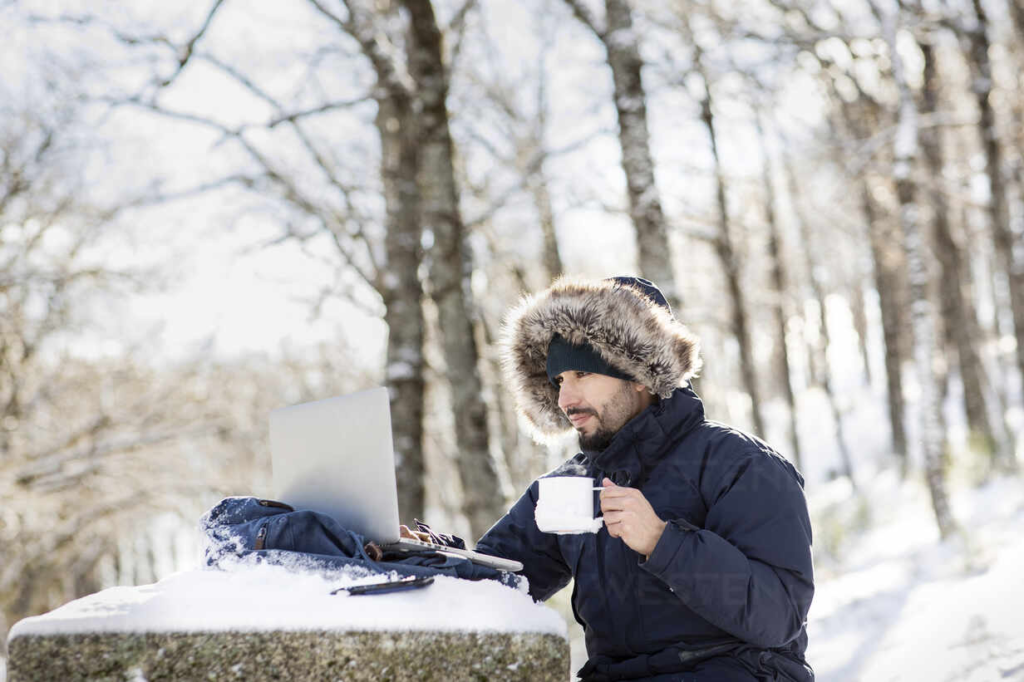
Don’t skip the snacks – your body needs fuel to fight the chill.
#8 💡 Drink the Heat
We doubt, at the age of manual outdoor work, that you need an explanation of why hot drinks heat you up…
…so here’s a list of simple drinks you can drink when working in cold weather.
- Tea/coffee
- Soup
- Hot chocolate
- Warm oatmeal
Remember that dehydration can zap energy when out on the job.
Dehydration is harder to detect in the cold, so make sure to be drinking some kind of hot beverage from an insulated flask at least every breaktime.
#9 💡 Eat like a Bear
We don’t mean honey and small mammals…
…more like any high-calorie foods that are easy to pack.
These kinds of foods are coal for the furnace of your body, giving you constant boosts of warm energy when working in the cold outdoors.
Foods like…
- Nuts
- Energy bars
- Whole grains
- Eggs
- Fruits
Safety 👷♂️
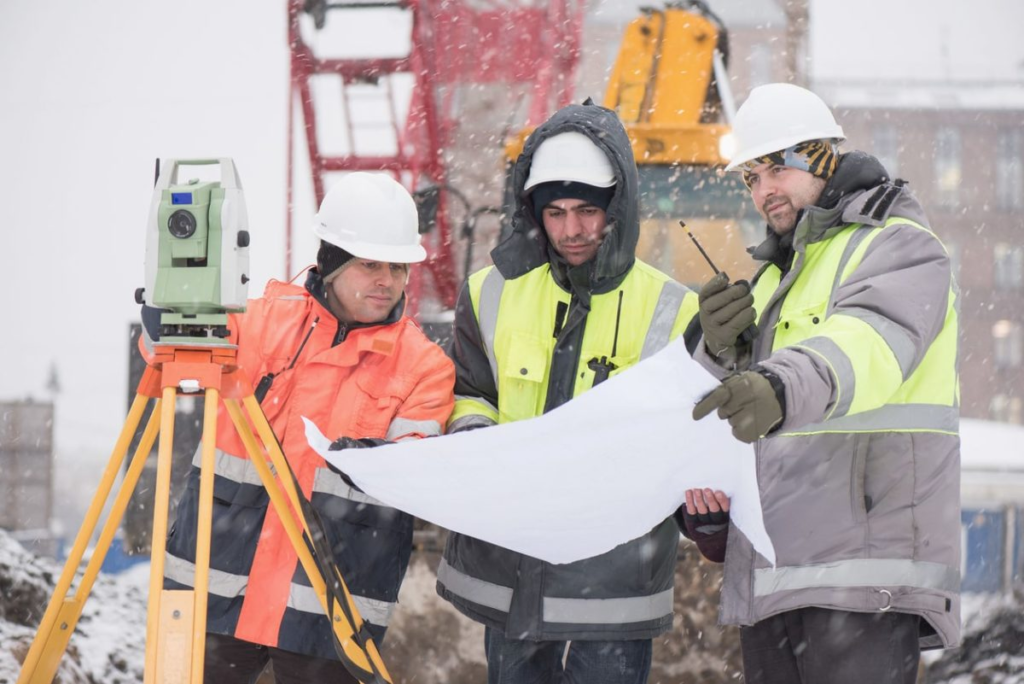
Follow the set advice when it comes to winter working outdoors.
#10 💡 Spot the Freeze
There are a bunch of signs when it comes to you or your colleagues being cold on the job.
Aside from the obvious side effect of ‘feeling cold’, you might notice you might notice…
- Body numbness
- Body tingling
- Red, blue, purple or brown skin in patches
- Waxy-looking skin
- Joint stiffness
- Blisters
If you notice any of these symptoms in one of your colleagues, immediately move them to a warm place, remove any wet clothing, and gently warm the affected area using warm water (not hot) or body heat.
#11 💡 Buddy Up
The buddy system might have worked well on your school trips, so there’s no reason it wouldn’t work in the working world.
Trust us, when you’re working in cold weather, it’s not always obvious to spot the symptoms (from tip #9) in yourself.
Working with a partner can be a fantastic way to notice the effects that you miss.
#12 💡 Avoid Metal Contact
Tongues stuck on lampposts are a classic sign of cold weather.
On the outdoor worksite, you might notice the same when your colleague is holding a buzzsaw with bare hands.
In all seriousness, making contact of bare skin on metal can result in immediate pain and numbness, quickly leading to ice burn or frostbite.
Wear gloves. Not just to avoid bare skin contact with metal, but also to keep your extremities warm, as mentioned above.
Environmental Preparations ❄️
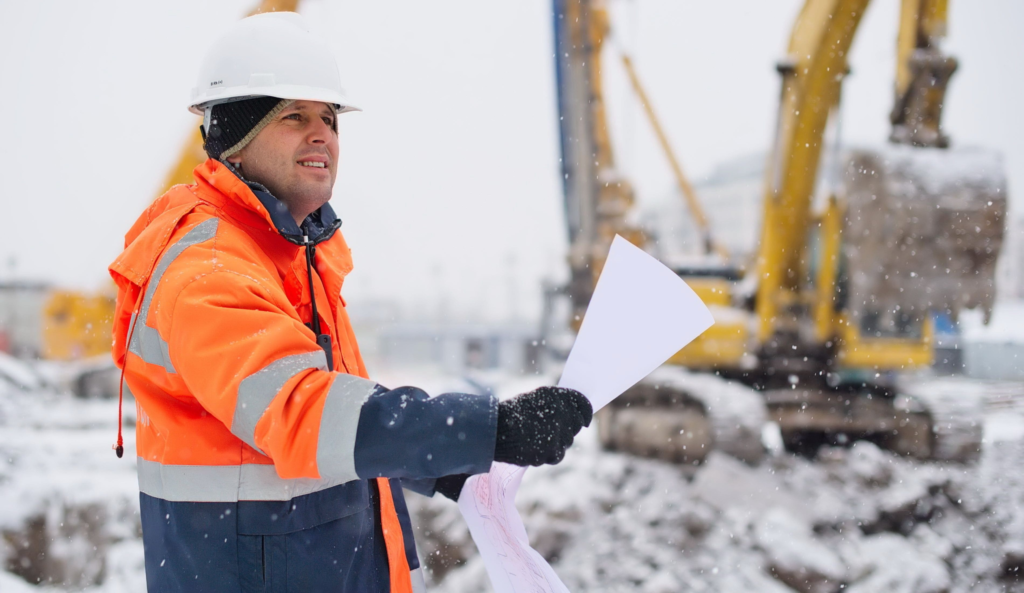
Don’t get caught out cold – make sure you’re prepared for the environment around you.
#13 💡 Pack your Safety
The most wonderful preparations for safety in outdoor work look like a full safety kit.
We’re talking…
- Emergency blankets
- Heat packs
- Extra clothes
- A thermometer
In many jurisdictions, these are items that your employer is legally required to provide, but if they don’t, it’s great to be prepared yourself.
#14 💡 Be Chill with Wind Chill
Sometimes, the weather forecast doesn’t paint the whole picture.
You’ll need to check wind chill charts, like those from OSHA, because that blustery wind can spike cold stress risks.
Wind chill charts let you know the ‘feels like’ temperature, as well as the estimated time it would take to get frostbite in those temperatures.
#15 💡 Train for the Cold War
At Ergo Global, we’re all about the training.
Why? Because training is the difference between a novice outdoor worker and an experienced one.
When it comes to working outdoors in the cold, training can literally be a case of life and death.
Employers are legally required to offer this training, so you can bring this up with your bosses.
Summary of Tips for Working in Cold Weather
| Category | What to do | How it helps |
|---|---|---|
| Clothing 🦺 | Wear layered, moisture-wicking, insulated clothing; protect extremities with hat, gloves, boots | Prevents heat loss, reduces frostbite risk; pack extra dry clothes |
| Scheduling 📆 | Take frequent warm-up breaks in heated shelters, especially below -7°C | Reduces cold stress; use relief workers for long tasks |
| Nutrition 🍎 | Drink warm, sweet liquids; eat high-calorie foods | Maintains energy and body temperature; prevents dehydration |
| Safety 👷♂️ | Watch for symptoms like numbness, reddening skin; use buddy system | Early recognition prevents serious conditions; partner assistance in emergencies |
| Environmental Preparations ❄️ | Carry safety kit with blankets, hot packs, extra clothes; check wind chill | Ready for emergencies; assess safety based on wind chill charts |
Cold weather is one of the biggest dangers in the world of industrial ergonomics.
The 15 tips above should help you fight the cold and deliver exceptional work in exceptionally difficult conditions.
Contact Ergo Global to learn more about training and support for your workplace!



